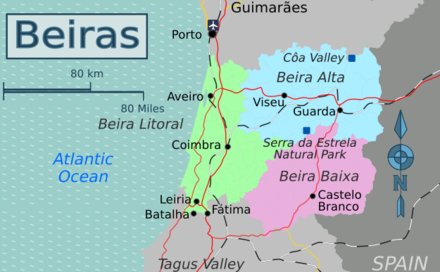The Beiras are three regions in central Portugal ranging from the Atlantic coast to the mountainous interior.
Regions

Northern inland portion of the historical Beira province.
Southern inland portion of the historical Beira province.
Coastal portion of the historical Beira province.
Cities
- Aveiro — the "Venice of Portugal", with canals and Arte Nouveau architecture
- Batalha — famous for the monastery, a
- Castelo Branco — home to a Templar Castle and Garden of the Episcopal Palace
- Coimbra — home to Portugal's oldest university (ninth in the world), a
- Fátima — popular pilgrimage destination where the Blessed Virgin Mary appeared to three shepherd children in 1917
- Guarda — highest city in continental Portugal, with a medieval cathedral
- Leiria — has a notable medieval castle
- Viseu — hilltop city with fine Romanesque and Gothic cathedral
Other destinations
- Serra da Estrela Natural Park — the highest mountain range in Continental Portugal
- Serra do Buçaco
- Serra do Caramulo
- Prehistoric Rock Art Sites in the Côa Valley 📍 — home to thousands of engraved rock drawings, dated from 22,000 to 10,000 years BCE, a
Understand
The Beiras (BAY-ruhsh, /ˈbɐj.ɾɐʃ/) provinces cover the centre of the country from the Atlantic Ocean to the Spanish border.
The Beirões have endemic age old traits. The ancient Celtic-Iberian people gradually come down from the safety of their highlands and mixed with Mediterranean newcomers arriving on the lower coastal regions and upriver from estuaries. The later Lusitanian tribes are known over time, perhaps for reasons of self preservation, for having retreated to the high ground and also preferred forest cover to open spaces. The Punic Wars/Roman period decimated much of those people and their culture, however, despite the migrations and mixing of different ethnicities, pockets of relatively unmixed groups survived within areas of difficult access. With invasions happening from time to time, the pattern of survival kept repeating itself, enabling the accumulated experience and traits to be passed along with every new generation. These traits manifested themselves as a mix of wisdom earned through hardship and the degree of stubborness typical of mountain people with the optimism inherent by the common need to cooperate in order to survive. New roads, bridges and the forces of globalisation have diluted such endemic characteristics somewhat, however "a leopard can't change its spots".
Visitor information
- Center of Portugal (Centro de Portugal), Casa Amarela, Largo de Sta Cristina, Viseu, NA°, NA°, +351 232 432 032, info@centerofportugal.com. Center of Portugal is the tourism authority for the entire Centro region, "from the coastline to the interior, from Aveiro to Óbidos". 2020-12-28
Get in
The Beiras lie between the country's two most important urban areas, centred between Lisbon, Porto and Vilar Formoso/Ciudad Rodrigo border crossing with Spain, thus benefiting from the railway and road connections between them. In particular the regular "Comboios de Portugal" long-distance trains, Alfa Pendular and Intercidades making scheduled daily stops at Coimbra and Aveiro railway stations, from there one can link up by bus or rental car to other destinations in the Beiras.
This strategic position, coupled with a relatively low population density (approx. 3 million), did not warrant the Beiras region to have its own airport. Both Lisbon and Porto international airports provide excellent connections with bus and train links radiating from there. Aerodromes near Coimbra and Aveiro exist to service private pilots and small aircraft.
Get around
Geographically the Beiras is not a very large area, nevertheless, its topography is made up of a variety of terrain types, ranging from mountains to coastal beaches. The main road network is comprehensive in both quality and quantity. The secondary roads vary from excellent to average and continuously meander through every little hamlet, field and village forever, it seems much larger than the actual size.
The railways connect Aveiro and Coimbra to Spain via Vilar Formoso but road travel remains the best option to move around and visit interesting places.
Motorbiking or cycling about are a good way of visiting out of the beaten track places.
Transdev offers regional bus services.
See
- Sanctuary of Our Lady of Fátima (Marian Shrine).
- Almeida fortress
Do
Visit the mountains of Estrela, Marofa, Gardunha, Lousa, Caramulo, and Bussaco.
Eat
Drink
Stay safe
Go next
- Cascais — beach town at the mouth of the Tagus (Tejo) River, known for the casino and high living at Estoril
- Douro Litoral — region in the north along the coast
- Porto – the northern capital, "Invincible City", along the river Douro and the Atlantic Ocean
- Lisbon (Lisboa) – the nation's capital and most popular destination, with several s
-Nelson_Ricardo_2500-Beiras.wav/440px-LL-Q5146_(por)-Nelson_Ricardo_2500-Beiras.wav)
